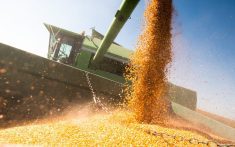MarketsFarm — August figures from the U.S. Department of Agriculture’s (USDA) world agricultural supply/demand estimates (WASDE) provided very few surprises and not much change after their release Friday.
However, crop production and carryout estimates were tightened from those in July.
USDA’s 2023-24 corn production estimate declined by 209 million bushels from July to 15.111 billion, slightly less than the average trade guess of 15.135 billion. The yield was projected to be 175.1 bushels per acre, close to average trade guesses, but below the July estimate of 177.5. As a result, ending stocks for new-crop corn dropped by 60 million bushels from the July estimate to 2.202 billion, a little bit more than the trade’s average estimate of 2.168 billion. For the 2022-23 marketing year, corn production came in at 13.73 billion bushels, while the yield was 173.3 bu./ac. and ending stocks are forecast at 2.262 billion bushels.
Read Also

Calling for bigger crops ahead of StatCan report
Statistics Canada will release its first survey-based production estimates for the 2025/26 crop year on Dec. 4, with general expectations for upward revisions to most major crops from the model-based estimates in September. However, as StatCan has shown a tendency to underestimate production in its December reports, many analysts expect actual production may be revised upward in subsequent reports.
U.S. soybean production is now forecast to be lower than in 2022-23. The agency estimated 4.205 billion bushels produced for 2023-24, down 41 million from the average trade guess and down 95 million from the July estimate. The projected yield was 50.9 bu./ac., 0.4 less than the trade’s average guess and 1.1 less than the July estimate. Ending stocks were estimated at 245 million bushels, 22 million lower than the trade’s average estimate and 55 million lower than USDA’s July estimate. In 2022-23, soybean production was at 4.276 billion bushels for a yield of 49.5 bu./ac. with ending stocks at 260 million.
Wheat production in the U.S. is expected to total 1.734 billion bushels in 2023-24 according to USDA, only five million less than both the trade’s average guess and the July estimate. The projected yield declined 0.3 bu./ac. from July to 45.8. Production of hard red and soft red winter wheat is set to increase by 54 million and 103 million bushels from last year, respectively, to 585 million and 440 million. Hard red spring wheat is projected to decline by 33 million to 416 million, while white wheat would also lose 33 million to 239 million. Durum production is expected to decline by seven million to 57 million.
However, total wheat ending stocks are set to loosen to 615 million bushels, 17 million more than the trade’s average guess and 23 million more than the July estimate, due to fewer exports. Last year, production was 1.65 billion bushels with a yield of 46.5 bu./ac. and ending stocks of 580 million.
The estimate for global corn ending stocks was down 3.07 million tonnes from July to 311.05 million, down from the 313.83 million estimated by the trade, but more than 297.92 million in 2022-23.
Global soybean ending stocks were pegged for 119.4 million tonnes, down from the July estimate of 120.98 million and less than the pre-report trade guess of 120.04 million. The 2022-23 total was 103.09 million.
The figure for worldwide wheat ending stocks was set at 265.61 million tonnes, down from the 266.53 million tonnes estimated in July and the average trade guess of 265.92 million. Last year, the total was 268.31 million tonnes.
— Adam Peleshaty reports for MarketsFarm from Stonewall, Man.
















